The girl with the ball (1987-1994)
The main points made in the two subsequent documents are the following:Ι.The "Point" is a structural concept that contains its self-negation = Motion..
II. Every change is a Change of Scale. The graphic representation of change, the spiral, should be seen as a spiral with ever-widening circles.
III. The Relation of Art to Science is essential. Art and Science express different semblances of Essence: Whole and Part, Indeterminate and Determinate, Absolute and Relative, but this does not mean that these Fundamental notions (and attributes) are not present together and in each of them (Art and Science) separately.
IV. Only through the Process of Cognition can a Causal Relationship be established between Art and Science.
"The Girl With The Ball" is a series which started in January, 1987.
For the moment it includes three life-size works (No 1, No 5, No 6), three works in half life-size (No 2, No 3, No 4), five works in one quarter life-size (parallel series) and many drawings in pencil and pastel.
The full title of the series is "The Girl With The Ball" or "Movement - Development of the Point".The theme of series is a girl in puberty, namely the transition from childhood to maturity, and at the same time a Point in space and time. I am treating it as thestructural element (part) of a Whole. As a part, it contains all the attributes of the Whole in an undeveloped form. Therefore it is self-evolving just like the Whole.
Thus, the Point appears as the infinitely small that contains the infinitely big.
A human being, being the most developed form of Nature that we know of, can also be Nature's Measure because it contains all its properties. Even the social condition of humankind as a species, with everything it entails in its difference from other species, is part of Nature.
Puberty is the Moment - Point when knowledge arising from an individual's personal experience encounters social action and consciousness, often with dramatic consequences.
The process of entering adulthood under the pressure of the wider space-environment calls for a re-examination of the facts of experiential knowledge which contains the main elements of the final destiny.
The ball and the hoop are playthings as well as perfect forms (in three or two dimensions - sphere, circle).
The image of a girl is also charged with many notions such as eroticism, potential procreation, etc.
In No. 1 and No. 2 (see sketches) the girl is curled around the ultimate purpose (ball).
 Νο. 1 Front view
Νο. 1 Front view
 No. 1 Side view
No. 1 Side view
 No.2
No.2
The movement of the axes of the limbs in relation to the tension in the contour lines endeavours to communicate the sense of a system at rest only because the forces opposing the tendency to turn inward have not prevailed. They are marginally in equilibrium.
In No. 3 and in No.4 (see drawings) motion in an outward direction begins.
Στο Νo 3 και Νo 4 (βλέπε σχεδιαγράμματα) αρχίζει η κίνηση προς τα έξω.
 No. 3 Front view
No. 3 Front view
 Νο. 3 Side view
Νο. 3 Side view
 No. 4
No. 4
The balance of the entire system is completed/exhausted (No.3), at the same time as it begins to be drawn into an outward motion. The dynamic outward motion of the sphere (ball) leaves behind its imprint, its negative (No. 4).
In No 5 and No 6 (see drawings) the unfolding is completed, but a new, self-existent system has not yet been created.
 No. 5 front view
No. 5 front view
 Νο. 5 Side view
Νο. 5 Side view
 Νο. 6 Side view
Νο. 6 Side view
 Νο. 6 Front view
Νο. 6 Front view
The dependence of the new figure on the old is decisive.
The hoop represents the imprint of the system's previous state, its graphic representation as well the projection of the sphere (ball) which serves to prop up the new system being created (Fig. 1).
The interdependence is emphasized by the ball which, being positioned in the middle of the synthesis (No. 5), operates both as the object whose projection is represented by the hoop in two dimensions (not Being - past), as well as the ultimate purpose of the becoming of the new system. (Fig. 1 & Fig. 2).



In No 6 it has already become apparent that the transition of a dynamic system from one state into another relative state containing the concept of evolution - development is not an accumulative process but a process of change of scale. It can be rendered graphically as a spiral with expanding circles.
In No 5 but even more in No. 6, the system changes its behaviour and becomes more open, albeit retaining its point of reference (the ball).
The prevailing trend could no longer be the spherical form directly. Though inherent, it is diffused in twists and spiral forms under the influence of the sphere (ball).
This is why in No 6 I placed the ball in this precarious position. I felt the urge to integrate it in a wider sphere-like but not yet visible system.If prolonged in a graphic representation, the basic axes will intersect each other on the perimeter of a circle whose diameter is equal to the height of the synthesis and whose center is situated at the base of the ball (Figure 3).
The destruction of a system's state of repose so that it may move on to another scale has as a consequence the creation of unpredictable situations, despite the fact that it contains elements of its origins as well as of its final "purpose".
The Universe may well be evolving along these lines. The vast variety of its forms probably reflects the process of its constantchange of scale.
Humankind must be evolving in much the same way. The vast variety of forms both in social and in private life probably express the process of constant change of human scale.
If we include time in the Geometry of space as a forth dimension, each measurement becomes non-reversible. The repetition of a process is only seemingly repetitive.
The notion of the Absolute is cancelled by the notion of the Relative only to be restored on a different scale, and so on.
Thus, the search for n dimensions is not a search for a world beyond experience, a transcendental world governed by its own rules.
The rationalism of formal logic when faced with the workings of processes seemingly lacking causality, "resolves" the problem by imagining an entirely different world existing in parallel with our own and simply giving intimations of its existence every now and then.
On the contrary, n dimensions express recognition of the involvement of parameters that cannot be ignored when it is necessary to be precise in describing phenomena.
The mathematical formulation of natural phenomena as non-reversible coincides, in my view, with the mathematical formulation of the process of change of scale.
These thoughts (briefly laid out here) arose out of my work on the "The Girl With The Ball" series and led me to the notion of"the Vortex".
In two works from the series, No 2 and No 4, the theme is dealt with through purely stereometric forms.
I did this for two reasons:
a) The investigate how the central idea operates when reduced to pure form and how the latter supports the idea, and
b) To study how the Universality of pure form becomes Individuality in order to acquire the notion of Existence
Finally, I shall venture a general thought about Art; this will necessarily be brief, given the nature of the text.
Every time the artist is faced with a blank canvas or easel, he/she is also faced, consciously or subconsciously, with the question, what is Art?
Every work of Art going out to face the world is an answer to this question. Not at the level of Form or Theme or any of those elements which may be called external features.
The answer lies in the manner in which it handles (expresses) the essential relation that creates it as substance (the relation between form and content) and in the manner in which it opens the way to the sought-after truth of Being, mainly expressed for Art (and partially for Science) by Beauty.Art believes in Beauty because it coincides with the profound Truth of its content, and confirms it.
Only if one accepts the above as valid, can one say that without Art the strong social cohesion necessary for the evolution of the tool, a precondition for the process of humanisation of the ape, could not possibly have existed.
In other words, without Art there could have been no social human History, neither the history we know nor any other form of it.
Continuing this thought,and given the preconditions already posited, one could contend that Science could not exist without Art.
No matter how much Art, in its course through history, has been split up into "-isms", it never relinquished its deeper purposes and never renounced the profound social ties mentioned above.
Furthermore, it can be seen that every time Art was able to rise to its great mission, in its great moments in history, its great achievements on the level of penetrating the laws of Universal Harmony were combined with an element of apparent simplicity, with regard to the form of the first level, which enabled it to become accessible more generally to the whole of society, that is, to break the cultural bulwarks of the social elites.
NOTE 1: The Point: Though totally deprived of any dimensions (non-existent...) it is a specific place determined by relationships and emerging as a constituent aspect (...existing) of existence.
NOTE 2: The work of Art differs from any other construction in that it does not serve a particular purpose. Not even the purpose of representing an idea figuratively.
The concept inherent in it belongs to the important components that ground its substance, its "Individuality".The other component is the material it is made of. The subject, descriptive elements, etc, are also components of its substance though of lesser importance.
Without "Individuality" the reduction to Universality becomes conventional or arbitrary. In this sense, art does not prove, butreveals. The answers it provides can fully satisfy only the Imagination.
Therefore, the above graphic representations of the axes have no greater value than assisting the reading of the text. Furthermore, the fact that they do not render the third dimension makes them all the more conventional...

"The Girl with The Ball Νο 1"
Parallel series
15 cm, bronze
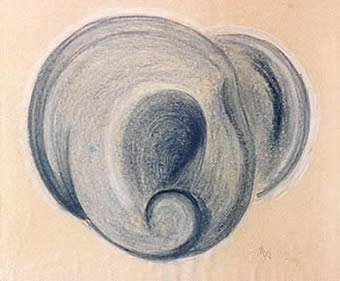
"The Girl with The Ball "
pastel on paper, 50 x 35 cm
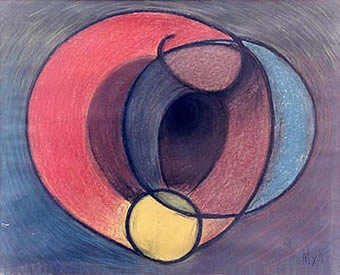
"The Girl with The Ball "
pastel on paper, 50 x 35 cm
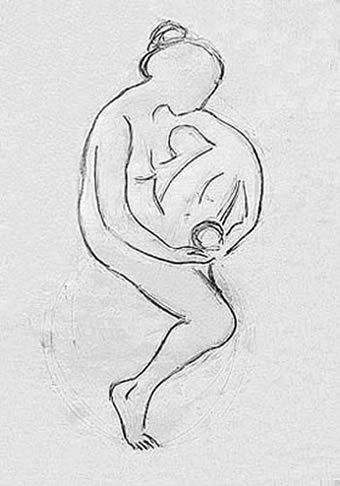
"The Girl with The Ball"
pencil on paper, 50 x 70 cm
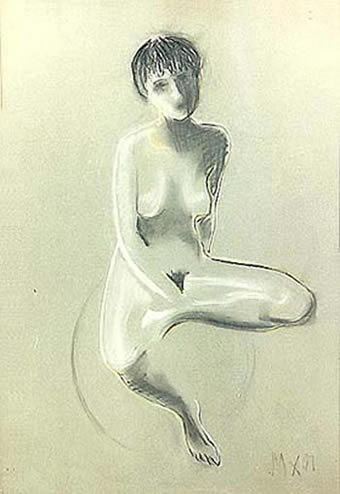
"The Girl with The Ball"
pastel on paper, 50 x 70 cm
NOTE 3: The reductions of a work to geometric forms, etc., or to the notions with which they are charged, constitute aspects, part of its substance. Though they may be considered as Structural, aspects of Essence, they are not sufficient to justify its existence.
If the geometrical, mathematical or other elements constitute the Whole of the work, then it is a Construction. By the way, the same is true for imitation as an end in itself.
The work of Art ought to be polarised between Abstraction and Realism. More correctly, it ought to "move" from the part (Individuality) towards the Whole (Universality) and vice versa.
The Concrete is a combination of Abstractions. In this sense, Realism here is meant as the Notion of the incontestableIndividuality (peculiarity) which must be inherent in the material body of the work (since it exists as such anyway) and which emerges from an original combination of Abstractions and Not from the subject or the depiction of familiar objects
Therefore, geometrical, mathematical, or other impressions cannot have the clarity of scientific formulations.
NOTE 4: The critical way of looking at everything cultivated by Art through the Aesthetic Measure includes Art itself. TheAesthetic Measure projected by a work of Art is first and foremost the measure of the work of Art itself, it refers to it. Without this property, the work becomes a mere depiction of things or ideas, what we call: "literary", "conceptual", "semiological", "propagandistic", "a construction", etc. It lacks the quality "in itself and for itself" that defines it as Existence. Beauty: that which captivates the senses and creates the feeling of potential identity with the Absolute - Fullness, Self-sufficiency. Freed of every type of Fashion, it is produced by a Particular Combination of Philosophical, Moral and Historical Values transformed into the Language of Visual Values of Art which, as an Objective Image Reveals, Confirms their reality. Beauty is thought-provoking because the Intellect wants to transform Revelation into immutable Knowledge.


_site_front.JPG)
_high.jpg)
.jpg)
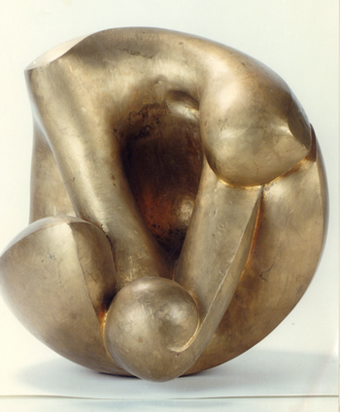

.jpg)
.jpg)
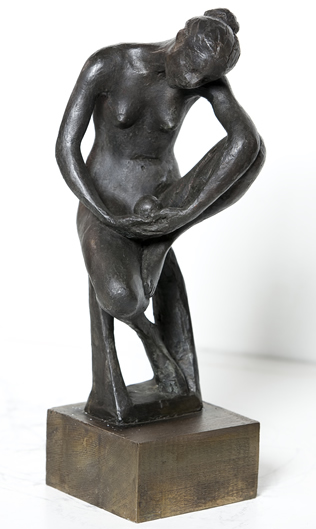
.jpg)
.jpg)
